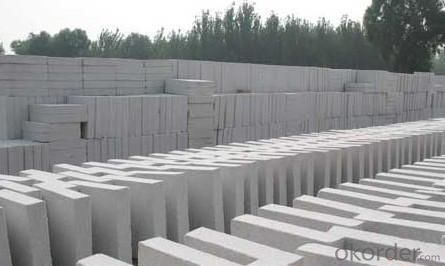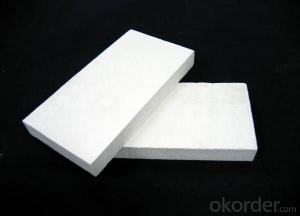Refractory JM Mullite Insulation Brick JM-26
- Loading Port:
- Shanghai
- Payment Terms:
- TT OR LC
- Min Order Qty:
- 10 m.t.
- Supply Capability:
- 1000 m.t./month
OKorder Service Pledge
OKorder Financial Service
You Might Also Like
Refractory mullite insulating refractory brick JM 23
Okorder series heat insulation brick
Okorder series thermal insulation brick is an effective, energy saving, low carbon, environmental protection advanced, according to the ASTM standard manufacturing products. Okorder series products are best Li Ning and insulation in all types of industrial furnaces in the metallurgical field, aluminum, petrochemical, electric power and glass ceramic materials. They can be used as part of the working layer of thermal insulation or non - melting. Products have been widely used in the following furnace, achieved satisfactory results.
Application of heat preservation brick
Metallurgical Industry: blast furnace, hot blast furnace, heating furnace, etc..
Petrochemical Industry: ethylene cracking furnace, hydrogen production furnace, primary reformer, heating furnace, etc..
Ceramic industry: roller kiln, kiln, etc..
Glass industry: glass furnace regenerator, etc.
Carbon industry: carbon furnace, etc..
Aluminum electrolysis industry: aluminum reduction cell, etc.
Other industries: tunnel kiln, shuttle kiln, etc..
Advantages of heat insulation brick
Low thermal conductivity: more porosity will bring good thermal insulation effect, energy saving.
High crushing strength: high crushing strength, volume stability.
Low heat storage: small heat storage to absorb more heat, energy-saving effect is obvious.
Gao Chundu: iron, alkali metal impurity content is low.
The precise size: Brick size processing precision, special shape cutting and grinding, accelerate the brickwork.
Insulating brick picture
Common problem solutions
1. What products do you have?
We have all kinds of refractory bricks, refractory casting materials, mortar, cement, ceramic fiber products, etc..
Or you can browse our products to choose what you need.
2. How to control product quality?
With strict quality control system throughout the material selection and production process, we have the quality of refractory materials and ceramic fiber products to meet customer requirements.
From the selection of raw materials, the quality of our control to start. The quality certificate of the raw material is required, each batch of the products are to be tested in the use of the forward line. In the production process, the quality control by the workers, and then each piece of classification, and through the quality supervision and inspection.
3. Can you give me a brief introduction to the application of your product?
My company is mainly engaged in refractories in the steel, cement, glass, ceramics, petrochemical, electric power and other industries.
4. What information do you need if I need you?
In order to select the right products, we will provide us with information, such as the United States, technical data, order quantity, product application, etc..
If you have any questions, please contact us.




- Q:Can insulating fire bricks be used in glass furnaces?
- Yes, insulating fire bricks can be used in glass furnaces. Insulating fire bricks are designed to have low thermal conductivity, which makes them ideal for use in high-temperature environments like glass furnaces. These bricks help to reduce heat loss from the furnace, resulting in improved energy efficiency and reduced operating costs. They also provide better insulation and help to maintain consistent temperatures inside the furnace, which is crucial for glass production. Additionally, insulating fire bricks have good resistance to thermal shock and can withstand the extreme temperatures and rapid temperature changes that occur in glass furnaces. Overall, the use of insulating fire bricks in glass furnaces can contribute to better furnace performance, increased productivity, and energy savings.
- Q:Can insulating fire bricks be used in the construction of ceramic tile kilns?
- Yes, insulating fire bricks can be used in the construction of ceramic tile kilns. Insulating fire bricks are specifically designed to withstand high temperatures and provide excellent insulation properties. They have low thermal conductivity, which means they help to retain heat within the kiln and prevent it from escaping, resulting in more efficient and effective firing of ceramic tiles. Additionally, their lightweight nature makes them easy to handle and install in the kiln structure. Overall, using insulating fire bricks in the construction of ceramic tile kilns can help improve energy efficiency, reduce heat loss, and ensure consistent and controlled firing temperatures.
- Q:Can insulating fire bricks be used for pizza ovens?
- Yes, insulating fire bricks can be used for pizza ovens. Insulating fire bricks are designed to withstand high temperatures, making them a suitable choice for creating a well-insulated and efficient pizza oven. They help retain heat, allowing the oven to reach and maintain the desired temperature for baking delicious pizzas.
- Q:Can insulating fire bricks be used for insulation in cryogenic applications?
- Yes, insulating fire bricks can be used for insulation in cryogenic applications. These bricks have excellent thermal properties that make them suitable for maintaining low temperatures and preventing the transfer of heat in cryogenic environments. They are designed to resist extreme cold and can effectively insulate against the loss of thermal energy, making them a reliable choice for cryogenic insulation.
- Q:Are insulating fire bricks safe to use?
- When used correctly and according to the manufacturer's instructions, insulating fire bricks are generally safe to use. These bricks are specifically designed to endure high temperatures and provide exceptional insulation, making them perfect for applications like lining kilns, furnaces, and fireplaces. Made from lightweight materials like alumina, silica, and other refractory materials, insulating fire bricks aim to minimize heat transfer, thus preventing the escape of heat from the enclosed area. This not only enhances the system's energy efficiency but also reduces the risk of overheating and potential fires, improving safety. To ensure the safe use of insulating fire bricks, it is crucial to install them properly and securely. This involves providing sufficient support and reinforcement to prevent collapse or shifting of the bricks. Additionally, it is essential to use suitable mortar or refractory cement to firmly join the bricks together, creating a sturdy and stable structure. While insulating fire bricks themselves are generally safe, it is important to note that they may contain small amounts of trace elements or materials that can be harmful if released into the environment. Therefore, it is advisable to follow the manufacturer's safety guidelines, which may include wearing protective gloves, goggles, and a dust mask when handling the bricks. In conclusion, insulating fire bricks are a safe and dependable choice for insulation in high-temperature applications. Nevertheless, it is crucial to take necessary precautions during installation and adhere to safety guidelines to ensure their proper and safe use.
- Q:Do insulating fire bricks absorb moisture?
- Insulating fire bricks do not absorb moisture, that is a fact. These bricks are manufactured from moisture-resistant materials like high-alumina or silica, which makes them perfect for situations demanding resistance to moisture. For instance, they excel in high-temperature environments or when utilized as insulation in fireplaces or kilns. The non-absorptive nature of insulating fire bricks aids in preserving their structural integrity and insulation effectiveness, even in humid conditions, as time goes by.
- Q:Are insulating fire bricks resistant to water absorption?
- Insulating fire bricks possess resistance against water absorption. Their design emphasizes low porosity and high density, effectively preventing water from penetrating their structure. This resistance to water absorption holds significance as water exposure can result in cracks or damage to fire bricks, thereby diminishing their insulation capabilities and lifespan. Consequently, insulating fire bricks emerge as an optimal selection for applications necessitating moisture resistance, including the construction of kilns, furnaces, or other environments characterized by high temperatures.
- Q:Can insulating fire bricks be used in refractory castings?
- Indeed, refractory castings can incorporate insulating fire bricks. Due to their lightweight nature and exceptional insulation abilities, insulating fire bricks are ideal for tasks that demand thermal insulation. Such tasks include the creation of linings in furnaces, kilns, and other equipment that operates at high temperatures. To achieve thermal insulation and minimize heat loss, insulating fire bricks can be utilized either as a layer or as an element within the refractory casting mixture. Furthermore, their low thermal conductivity aids in reducing energy consumption and sustaining elevated temperatures within the casting.
- Q:Can insulating fire bricks be used in the construction of cremation chambers?
- Insulating fire bricks have the capability to be utilized in the construction of cremation chambers. These bricks are manufactured using lightweight materials such as vermiculite or perlite, which possess remarkable insulating properties. These properties render them suitable for high-temperature applications like cremation chambers, where they are instrumental in maintaining a consistent and controlled temperature. The utilization of insulating fire bricks in the construction of cremation chambers yields numerous benefits. Firstly, these bricks aid in enhancing energy efficiency by minimizing heat loss. This subsequently leads to reduced fuel consumption and cost savings. Secondly, the insulating properties of these bricks ensure that a stable temperature is maintained within the cremation chamber, which is crucial for achieving efficient and complete combustion of the deceased. Furthermore, these bricks are lightweight and easy to handle, thereby facilitating a more convenient and efficient construction process. Nevertheless, it is worth noting that although insulating fire bricks can be employed in the construction of cremation chambers, they are typically used in conjunction with refractory fire bricks. Refractory fire bricks are fabricated from materials such as clay or silica, which possess the ability to withstand exceedingly high temperatures. These bricks are installed in areas of the cremation chamber that come into direct contact with the flames, while insulating fire bricks are utilized in areas that require insulation. In conclusion, insulating fire bricks are a suitable choice for the construction of cremation chambers due to their excellent thermal insulation properties and ability to contribute to the efficient and controlled operation of the cremation process.
- Q:Can insulating fire bricks be used in the construction of refractory linings?
- Indeed, the utilization of insulating fire bricks is possible when constructing refractory linings. These bricks are explicitly engineered to possess exceptional thermal insulation characteristics, rendering them highly suitable for situations necessitating the containment of extreme temperatures. They are frequently employed in the establishment of furnaces, kilns, and other environments that experience elevated heat levels. The insulating attributes of these bricks aid in diminishing heat dissipation, enhancing energy efficiency, and upholding a consistent temperature within the refractory lining. Furthermore, insulating fire bricks are lightweight and effortless to manipulate, thereby constituting a pragmatic selection for the construction of refractory linings.
1. Manufacturer Overview |
|
|---|---|
| Location | |
| Year Established | |
| Annual Output Value | |
| Main Markets | |
| Company Certifications | |
2. Manufacturer Certificates |
|
|---|---|
| a) Certification Name | |
| Range | |
| Reference | |
| Validity Period | |
3. Manufacturer Capability |
|
|---|---|
| a)Trade Capacity | |
| Nearest Port | |
| Export Percentage | |
| No.of Employees in Trade Department | |
| Language Spoken: | |
| b)Factory Information | |
| Factory Size: | |
| No. of Production Lines | |
| Contract Manufacturing | |
| Product Price Range | |
Send your message to us
Refractory JM Mullite Insulation Brick JM-26
- Loading Port:
- Shanghai
- Payment Terms:
- TT OR LC
- Min Order Qty:
- 10 m.t.
- Supply Capability:
- 1000 m.t./month
OKorder Service Pledge
OKorder Financial Service
Similar products
New products
Hot products
Related keywords




























